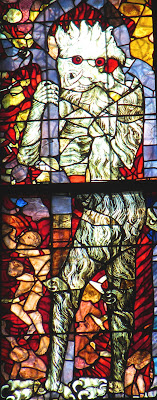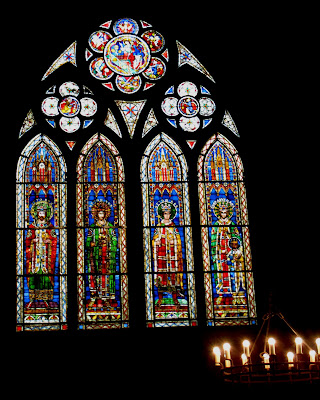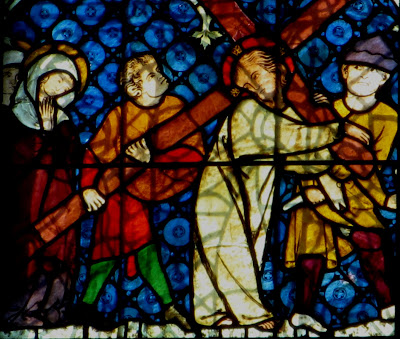It is 466 feet high and was the tallest building in the world from 1647 to 1874. It is now the sixth tallest church in the world (behind Ulm [#1] and Cologne [#3], both churches we have climbed up into the towers of). The height is staggering, emphasized by the relatively small square which was not big enough to allow a picture that could frame the whole building.
It was very intimidating to come up through the streets near the cathedral and have it overwhelm the surrounding buildings.
For my generation, used to skyscrapers, to have that feeling, it is hard to over-estimate the feelings it must have generated in the people of medieval times.
A number of buildings existed on this site before the current cathedral, including one built by the Romans. In 1015, the first stone of a new Romanesque cathedral was placed over the ruins of the prior Carolingian cathedral which was destroyed by fire. This new cathedral also burned to the ground in 1176. Basel Munster was just being completed and it was decided that this new cathedral to be built, using the existing foundations, would be even more beautiful than Basel was. It started out to be Romanesque, but a team coming from Chartres Cathedral in 1225 suggested a Gothic style. The west facade, the front of the cathedral, with thousands of figures,
has many similarities to Chartres and is considered a masterpiece. Goethe said, "The more I contemplate the facade of the cathedral, the more I am convinced of my first impression that its loftiness is linked to beauty." The central portal
is flanked by statues of Old Testament prophets.
Above the doors, four registers have scenes from the Old and New Testament,
with the Passion of Christ as the central theme at the center.
I particularly love the four ribs which outline the arch and have mini-scenes in them. This is, perhaps, John the Baptist, about ready to lose his head.
This may be St. Peter, being crucified upside down on a cross.
The left, north, portal, has 14th century statues representing the virtues striking down the vices. I love how they stand upon vice and also thrust their spear points into it.
The rose window is the central point of the facade.
Above it is the gallery of apostles. From the inside, the rose window features ears of wheat, symbolizing the commercial power of Strasbourg in the Middle Ages.
The north tower was completed in 1439. A south tower was planned, but was never built. For 157 years, from 1524 to 1681, the cathedral was a Protestant church, as determined by the City Council, as a result of preaching during the Reformation by John Calvin and others. It returned to Catholicism when Louis XIV of France occupied the city, returned it to France, and celebrated a mass in the cathedral on October 23, 1681. The insides were redesigned for the liturgy of the Counter-Reformation. Below, looking through the central nave, from the west end toward the east end.
Below, just the opposite, from the east looking toward the west end and the rose window.
There were plans to destroy the tower during the French Revolution. However, a local locksmith made a huge Phrygian cap, a symbol of the revolution, out of metal that covered the spire, and saved it. During World War II the cathedral was seen as a symbol by both side. Adolph Hitler visited it on June 28, 1940. During the war the stained glass windows were removed and stored in a salt mine. However, British and American bombs hit the cathedral during air raids on Strasbourg on August 11, 1944. Damage from the war was only completed in the early 1990s. In October 1988, when Strasbourg was commemorating 2,000 years as a city, Pope John Paul II visited and celebrated mass in the cathedral. The stained glass windows are mostly from the 14th century. The windows were spectacular.
There are some from the late 12th century and 13th century and some from the 20th century. In the north nave, the 13th century windows feature emperors of the Holy Roman Empire.
The south part of the nave features episodes from the life of the Virgin Mary and Christ.
The pulpit is from 1486.
The suspended pipe organ on the north side of the central nave is from 1385 and 1491, but with new mechanisms as of 1981.
The chancel is Romanesque and has a stained glass window at the center, called the "Strasbourg Madonna,"
given by the Council of Europe in 1956 to replace the one destroyed during World War II. The Virgin is dressed in blue. In her lap, the baby Jesus wears a red outfit (a symbol of royalty) and holds a lily, the emblem of the city of Strasbourg.
There are also neo-Byzantine frescoes from the 19th century. Below is a frescoe showing Noah, Abraham, Isaac, Israel and Joseph.
Below it is a frescoe of Abraham getting ready to sacrifice Isaac, a lamb next to him and the hand of an angel reaching out to stop the knife.
The astronomical clock in the south transept was begun in 1547. It was replaced by a new one built from 1838 to 1843.
Near the astronomical clock is the pillar of angels, the central pillar of the south transept, built in around 1230. It features the Last Judgment, with the four evangelists (Matthew, Mark, Luke and John),
angels playing the trumpet,
and Christ above them. The cathedral is the second most visited in France, after Notre Dame de Paris, and well ahead of Chartres. We climbed the 330 steps to the first platform with a spectacular view of Strasbourg.
Unfortunately, we could not go any higher into the spire. The platform is a gallery of graffiti, but it is historical graffiti, from the 17th to the 19th centuries, carved into stone. This was unlike the graffiti we saw later in the tower at Cologne where it was painted onto the stone and all within the last two decades.
Some figures viewed from the platform.
It is not readily apparent that the cathedral is in the form of a cross. This can best be seen from the platform where the transept forming the cross, including the crossing tower, are readily apparent. The transept is relatively small and is much farther toward the east-end than is customary in a Gothic church.
Flying buttresses.
The south side of the church.
The south transept and building to the east end.
The area surrounding the cathedral is old and beautiful and along with the cathedral, made Strasbourg one of our favorite cities to visit.
About a block away is a statue of Johannes Gutenberg, who was in Strasbourg when he perfected the secrets of printing, about 1440.




















































It's amazing to me to see how one building can encompass so much history in its architecture. We don't have much experience with that in modern building, do we? I also like how the church changed hands (French/German) and religion (Catholic/Protestant). Definitely one of those churches "built for power."
ReplyDeleteI love all the pictures you took of the outside of the building. I think you could spend weeks just studying and admiring the exterior.
ReplyDeleteLove the pictures and your nuggets of history. This brings me right back to Strasbourg and my visit last March.
ReplyDeleteMy husbnd, John was stationed in France, from April 1965 to October 1966. We visited Strasborg several times. He died last year so the pictures are such a memory. We would wak about in amazement of the city, the Catheral, and history.
ReplyDeleteSo sorry for your loss...May your wonderful memories be of some comfort to you.
DeleteI see that you are using WordPress on your blog, wordpress is the best.*:~-ヤ
ReplyDeleteInteresting blog, it reminds me of Strasbourg, it is considered to be the capital of Europe due to the presence of several European Union and other institutions in the city.
ReplyDeleteI tried to write a blog about Strasbourg, hope you also like it https://stenote.blogspot.com/2018/06/strasbourg-city-of-europe.html